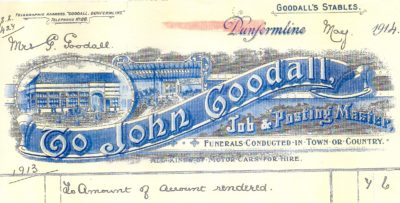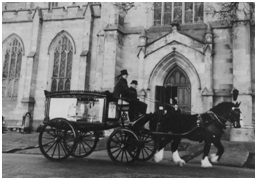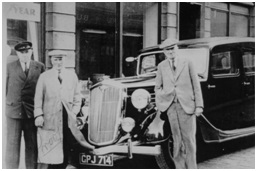John Goodall and Co. Ltd
by George Beattie
In 1868, at the age of seventeen years, Mr John White Goodall set up his horse and cab business in a single stall stable in what is now known as Commercial School Lane, off East Port, Dunfermline. His assets at that time comprised one horse, one cab and a set of harness. The horse cost £3.00, the cab £19.00 and the harness 30 shillings. Soon afterwards he added, at a cost of £3.00, a dog cart – a two wheeled carriage with seats back-to-back. Recognising the possibilities of expanding this trade, which was then virtually in its infancy, he soon acquired more extensive stabling accommodation in New Row, to the rear of the East Port Hotel, which at that time was owned by his sister Mrs Tullis.
Mr Goodall’s business rapidly expanded and, in 1875, he obtained a lease of the Royal Hotel Stables at 58 Queen Anne Street, these being the premises from where the Goodall family would conduct business for the next 100 years. Later, Mr Goodall took advantage of an opportunity to become owner of the Queen Anne Street property which he subsequently converted into one of the largest, and best appointed, stabling yards in Scotland. It was commonplace that Mr Goodall, during the years of his ever growing business, was never known to send out a yoke (horse and carriage) to which the slightest exception could be taken. Horse, harness, cab and driver were, so to speak, of a piece.
During the later part of the nineteenth century the resources of Mr Goodall’s stables were regularly drawn upon for the carrying out of practically all local and district functions in which horses and vehicles were required. This, on more than one occasion, included transporting royalty on visits to Dunfermline. A good example of Mr Goodall’s organisational ability was his yearly feat of supplying some thirty horse drawn brakes and charabancs for the then famous drives to the country-side of the auld weavers of Dunfermline.
At a time when funerals by motor vehicle were undreamt of, the great majority of Dunfermline and district funerals were conducted from the resources of Mr Goodall’s stables. With a pair of stylish black Belgian horses drawing the hearse, their long black tails reaching almost to the ground; and specially selected horses yoked to the coaches accommodating the mourners, a funeral cortege in those days was a really impressive spectacle. Before the introduction of motor vehicles to the fire service there was always at Mr Goodall’s establishment, and always partly harnessed, a pair of fast horses which, on receipt of a telephone call, were speedily dispatched to the fire station, then in Campbell Street, yoked to the fire engine, and were ‘soon’ on their way to the scene of the fire.
In his employment around the turn of the century Mr Goodall had a staff of drivers who, like their master, were expert horsemen who took pride in their outfits. These drivers, all well known and highly respected in the community, were part and parcel of the everyday life of the town. A faithful and esteemed employee was David Keddie, the ostler (groom) for many years who, under Mr Goodall’s supervision, saw to it that customers’ requirements were properly complied with. Others who did sterling service in those days were David Ross, James Deuchars, Alexander Scott, and Sandy Charlton, who was said to be the only one of all the drivers who could safely be trusted with ‘Kitchener’, a fine looking but fractious bay which did many years valuable service at Goodalls. Billy Brown, who was recognised as an exceptionally careful driver, was a great favourite. William Hay, James Blackwood and William Robertson did the railway station work for a long number of years and David Dobie who, in riding britches and buff leggings, was a ‘kenspeckle’ figure as he strutted about the streets on his way to and from the stable yard. Besides the famous ‘Kitchener’, other horses which did sterling service were Old Major, The Sultan and Butter’s Mare.
In 1910 Mr Goodall added motor cars to his business and subsequently became involved in the sale and repair of these vehicles. John Goodall retired in 1913 and sold the business to his nephews David Goodall and David B. Tullis, the former having become manager of the hiring department in 1910.
In 1919 Mr Archibald McCulloch, a native of Motherwell, who had served an apprenticeship with the ill-fated Argyll Motor Company of Alexandria, and who had later been manager of the Fife Motor Company in Dunfermline, was assumed as a partner in Goodall’s business.
In 1921 the partners parted with all their horses and converted the hiring part of the business completely over to motor cars. Like that of the horse drawn era, Goodall’s car hire operation had a long standing reputation for efficiency and luxury. Few visitors to the town who used Goodall’s vehicles over the next 30 years failed to remark on the elegant lines and the cleanliness and comfort of the vehicles which the firm employed. Again, like their horse drawn predecessors, these vehicles were regularly used for public engagements and large functions throughout the area and twice carried King George VI and Queen Elizabeth during visits to Dunfermline and Rosyth.
In tandem with the hiring department the motor car sales and engineering side of the business continued to grow between the wars and Goodall was, at one time or another, selling agents for a number of vehicle manufacturers such as Rolls-Royce, Swift, Dodge, Bean, Arrol Johnston, Ford, Angus Sanderson, Belsize, Ruston Hornsby, Argyll, Wolseley, Galloway, Rover, Citroen, Vulcan, Durant, Studebaker, Renault and Hillman. Many of these manufacturers went out of business in the twenties and thirties with only a few of the above companies such as Roll-Royce, Ford, Wolseley, Rover, Citroen, Renault and Hillman surviving beyond the Second World War.
In 1930, Goodall’s became sole distributors of Wolseley motor cars for Fife and Kinross, a role the firm was to fulfil for some forty years. This arrangement meant that every new Wolseley motor car sold in Fife and Kinross areas had to pass through Goodall’s garage, if only on paper. During this era Goodall’s also became agents for Austin, Riley, Morris and MG motor cars. This proved a useful combination as these manufacturers along with Wolseley subsequently came under the umbrella of the British Motor Corporation with the advent of nationalisation in 1952.
At the start of the motoring era the storage of petrol created obvious safety problems for motor dealers like Goodall. Their first petroleum spirit storage licence was for seventy gallons which was contained in two gallon tins and delivered to them by horse-drawn lorry from Dunfermline’s first oil depot at the old Colton Station in William Street. Goodall’s first petrol storage tank, installed after the first world war, held 500 gallons; the petrol being transferred to the customer’s car by a hand-cranked pump. On a busy day the pump attendant’s life was a strenuous one. Less elbow grease was required with the development of the to and fro handle pump.
Then, in 1933, Goodall installed their first electrically operated pumps and in front of the pumps they also installed their famous electric powered car turntable. Lack of space inside the garage forced this innovation upon them. An under cover filling station with an electric turntable proved to be a sales gimmick of the first order. It was the only one of its kind in Fife, perhaps in Scotland, and sales boomed. It should be pointed out that the Fife Motor Company also had a turntable at St. Margaret’s Street, but this one was manually operated. The introduction of new regulations in 1960 meant it was no longer permissible to have a filling station within a garage and this resulted in Goodalls acquiring derelict properties adjacent to their Inglis Street entrance and locating a purpose built filling station there.
In 1945, Mr Tullis retired and at that time the firm was converted into a limited company with David Goodall and Archibald McCulloch as joint Managing Directors. Shortly afterwards, in 1946, Mr David Goodall’s son, Cameron, on his demobilisation from the Royal Air Force joined the firm and almost immediately was appointed to the Board. Cameron Goodall had served in the Air Force for almost five years as a pilot and, during the later years of the war had served with distinction as a member of the Squadron of the Balkan Air Force Command engaged on special duties which consisted of dropping supplies and agents in the Yugoslavian, Austrian and South Poland areas of partisan activity.
Also at that time Mr Charles Inglis, who had seen many years service as a salesman for the firm, was assumed onto the Board. A time-served motor engineer, Charlie Inglis enlisted in the Gordon Highlanders in the First World War and served in France where was wounded at La Bassee. He re-joined Goodall’s on demobilisation in 1919. In the Second World War, he was a member of the Royal Observer Corps. until 1942. Two years later he received a commission in the Royal Navy Volunteer Service as a Training Officer for the local Sea Cadet Corps. In the course of his long service with Goodall’s, Charlie attended Scottish Motor Shows regularly from 1921.
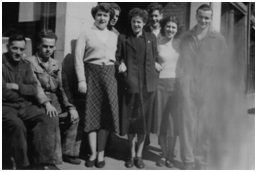
Goodall’s staff 1947 – left to right:- Jimmy Brown (tyre man), ‘Ginger’ Buchanan, Anne Walker, Jimmy Jackson, Lorna Ramsey, John McEwan, Betty Stirling (Lumsden), & George McDonald

C. 1955 – Upper – Goodall’s Service Area
Lower – Goodall’s Workshop with the Inglis Street entrance in the distance
1950 saw the closure of Goodall’s hiring department in order to facilitate 100% concentration on the sales and service of motor vehicles and the expansion of the firm in that direction. This meant the demise at that time of Goodall’s well known fleet of beautiful limousines which had given sterling service to the community and had been privileged to carry members of the British Royal family and such august visiting dignitaries as Prince Hirohito of Japan, during a pre-war visit to Rosyth Dockyard, Mr Andrew Carnegie and others.
In 1960, David Goodall died whilst still taking an active interest in the firm and Cameron Goodall took his late father’s place as joint Managing Director. Archie McCulloch retired in 1968 at which time Cameron Goodall assumed sole responsibility as Managing Director. Ann Walker, then office manager, described Archie McCulloch as being a real gentleman. Shortly afterwards, also in the sixties, three long-serving employees viz. Charles Inglis, Thomas Saunders and Hugh Kennedy were appointed Executive Directors.
Others playing prominent roles with Goodall around this time were Miss Ann Walker, office manageress, Jimmy Jackson, workshop manager, Jimmy Gourlay, stores manager, and Jimmy Thomson, petrol pump attendant. One of Goodall’s longest serving employees was Hugh Kennedy, who joined the firm as an apprentice motor mechanic in the 1920s. After serving five years as an apprentice and one year as an ‘improver’, Hugh left Goodall’s for a mechanic’s job at Alexander’s Bus Garage in St Leonard’s Street, Dunfermline. He returned to Goodall’s in 1934 and was subsequently promoted to workshop foreman in 1942. In 1950 he was appointed service director, a position he held until he retired in 1976.
 In an article in the Dunfermline Press of 23rd April, 1976, Hugh recalled that, in his early days as an apprentice at Goodall’s, when the firm was agents for a variety of makes of motor cars, and also Dodge buses. He said that he and other apprentices were up and down to London like ‘yo yos’ for buses and also to Cowley, Coventry and Birmingham for new cars. They went south by overnight train, and drove the vehicles back to Dunfermline, via Carlisle and Stirling, there being no Kincardine Bridge at that time. Even the main North Road and the road from Carlisle to the north, had no by-passes and so the route lay through towns and villages where buses were limited to 10 miles per hour. One week Hugh was three times down to London, the third time being on the Saturday for a bus which was to be on service to Aberdour on the Sunday afternoon. He left London in the forenoon, and, in spite of the numerous speed restrictions, he reached Dunfermline at 4 o’clock on the Sunday morning. One Christmas morning (not a holiday in Scotland at that time) he arrived in London with skid chains for a bus he was to drive back to Dunfermline. In spite of the wintry weather he decided not to put the chains on. His bus went into a skid as he was passing through Grantham, and skidded some distance broadside before coming to a halt. Fortunately, there was no other traffic on the street. By the time he reached Bowes and Broughton, the cross over to Carlisle, the road was so snowy and ice-bound that he had to stop and put the chains on the wheels. The number of buses he saw ditched by the road-side emphasised the need for caution.
In an article in the Dunfermline Press of 23rd April, 1976, Hugh recalled that, in his early days as an apprentice at Goodall’s, when the firm was agents for a variety of makes of motor cars, and also Dodge buses. He said that he and other apprentices were up and down to London like ‘yo yos’ for buses and also to Cowley, Coventry and Birmingham for new cars. They went south by overnight train, and drove the vehicles back to Dunfermline, via Carlisle and Stirling, there being no Kincardine Bridge at that time. Even the main North Road and the road from Carlisle to the north, had no by-passes and so the route lay through towns and villages where buses were limited to 10 miles per hour. One week Hugh was three times down to London, the third time being on the Saturday for a bus which was to be on service to Aberdour on the Sunday afternoon. He left London in the forenoon, and, in spite of the numerous speed restrictions, he reached Dunfermline at 4 o’clock on the Sunday morning. One Christmas morning (not a holiday in Scotland at that time) he arrived in London with skid chains for a bus he was to drive back to Dunfermline. In spite of the wintry weather he decided not to put the chains on. His bus went into a skid as he was passing through Grantham, and skidded some distance broadside before coming to a halt. Fortunately, there was no other traffic on the street. By the time he reached Bowes and Broughton, the cross over to Carlisle, the road was so snowy and ice-bound that he had to stop and put the chains on the wheels. The number of buses he saw ditched by the road-side emphasised the need for caution.
Hugh also pointed out that in the early days Goodall’s operated a 24 hour breakdown service, and he recalled having to travel as far as Ullapool, in the north-west of Scotland, with a spare part for a customer’s car which had broken-down there. Only soaring costs forced garage after garage to abandon the 24 hour service and forced motorists look to their own resources. Hugh did say, however, that it was only a few years previous that he was about to leave for a football match at East End Park, one Saturday afternoon, when his phone rang. A woman informed him that her husband’s car had broken down in Rosyth. Stifling a sigh, Hugh assured her that he would ‘go down and see what he could do’. The woman snapped back, ‘You’d better get it sorted quickly or my husband will be flaming mad at being late for the football match’.
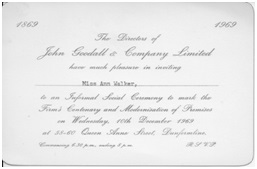 In 1969, Goodall’s celebrated their centenary by carrying out a modernisation of the premises and entertaining staff and customers at an informal social function within the main showroom. The invitation below indicates that the function, on Wednesday, 10th December, 1969, would commence at 6.30 pm and end at 8 pm. No late nights then, but of course the staff would be working on the Thursday morning.
In 1969, Goodall’s celebrated their centenary by carrying out a modernisation of the premises and entertaining staff and customers at an informal social function within the main showroom. The invitation below indicates that the function, on Wednesday, 10th December, 1969, would commence at 6.30 pm and end at 8 pm. No late nights then, but of course the staff would be working on the Thursday morning.
Goodall’s continued to play a prominent role in Dunfermline business life and remained independent until 1975 when the company was acquired by Messrs. Taggart (Motherwell) Ltd. Goodall’s remained in Queen Anne Street until October, 1976, when the premises closed and the staff, with Cameron Goodall still at the helm, transferred to the Halbeath Road premises of the former Fife Motor Company which had also been taken over by Taggart and now traded under the name of Taggart (Fife) Ltd.
Although Cameron Goodall remained as Managing Director of Taggart (Fife) Ltd., until his retiral in 1981, the firm of John Goodall & Co. effectively ceased trading in 1976 when the doors finally closed at 58 Queen Anne Street, with the premises subsequently being demolished to make way for the Kingsgate Shopping Centre.
